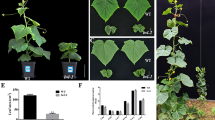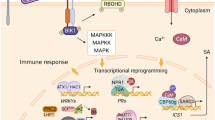Abstract
The full-length nucleotide sequence of a barley (Hordeum vulgare L.) leaf mRNA, found to increase rapidly in amount during infection attempts by the powdery mildew fungus (Erysiphe graminis DC. ex Mérat), is reported. The mRNA encodes a polypeptide of 809 amino acid residues which, by sequence comparison, was identified as a member of the 90 kDa heat shock protein (HSP90) family. The encoded protein most resembles the endoplasmic reticulum (ER) resident HSP90 protein, the 94 kDa glucose-regulated protein (GRP94) of vertebrates, as it possesses both the characteristic N-terminal domain including a signal peptide sequence and the C-terminal ER retention signal (Lys-Asp-Glu-Leu). A transcript cross-hybridizing at high stringency accumulated rapidly in leaves upon heat shock treatment. Genomic DNA blot analysis indicated the presence of a family of related genes in the barley genome.
Similar content being viewed by others
References
Anderson MLM, Young BD: Quantitative filter hybridization. In: Hames BD, Higgins SJ (eds) Nucleic Acid Hybridization: A Practical Approach pp. 73–111. IRL Press, Oxford (1985).
Ausubel FM, Brent R, Kingston RE, Moore DD, Smith JA, Seidman JG, Struhl K: Current Protocols in Molecular Biology 1987–1988. Wiley, New York (1987).
Bayles CJ, Aist JR: Apparent calcium mediation of resistance of an ml-o barley mutant to powdery mildew. Physiol Mol Plant Path 30: 337–345 (1987).
Binart N, Chambraud B, Levin JM, Garnier J, Baulieu E: A highly charged sequence of chick hsp90: a good candidate for interaction with steroid receptors. J Steroid Biochem 34: 369–374 (1989).
Bol JF, Linthorst HJM, Cornelissen BJC: Plant pathogenesis-related proteins by virus infection. Annu Rev Phytopath 28: 113–138 (1990).
Brandt J, Thordal-Christensen H, Vad K, Gregersen PL, Collinge DB: A pathogen-induced gene of barley encodes a protein showing high similarity to a protein kinase regulator. Plant J 2: 815–820 (1992).
Bryngelsson T, Collinge DB: Biochemical and molecular analyses of the response of barley to infection by powdery mildew. In: Shewry PR (ed) Barley: Genetics Biochemistry, Molecular Biology and Biotechnology, pp. 459–480. CAB International, Wallingford (1991).
Cho BH, Smedegaard-Petersen V: Induction of resistance to Erysiphe graminis f.sp. hordei in near-isogenic barley lines. Phytopathology 76: 301–305 (1986).
Chrispeels MJ: Sorting of proteins in the secretory system. Annu Rev Plant Physiol Plant Mol Biol 42: 21–53 (1991).
Collinge DB, Milligan DE, Dow JM, Scofield G, Daniels MJ: Gene expression in Brassica campestris showing a hypersensitive response to the incompatible pathogen Xanthomonas campestris pv. vitians. Plant Mol Biol 8: 405–414 (1987).
Collinge DB, Slusarenko AJ: Plant gene expression in response to pathogens. Plant Mol Biol 9: 389–410 (1987).
Conner TW, LaFayette PR, Nagao RT, Key JL: Sequence and expression of a HSP83 from Arabidopsis thaliana. Plant Physiol 94: 1689–1695 (1990).
D'Amico L, Valsasina B, Daminati MG, Fabbrini MS, Nitti G, Bollini R, Ceriotti A, Vitale A: Bean homologs of the mammalian glucose-regulated proteins: induction by tunicamycin and interaction with newly synthesized seed storage proteins in the endoplasmic reticulum. Plant J 2: 443–455 (1992).
Denecke J, Goldman MHS, Demolder J, Seurinck J, Botterman J: The tobacco luminal binding protein is encoded by a multigene family. Plant Cell 3: 1025–1035 (1991).
Denecke J, Rycke RD, Botterman J: Plant and mammalian sorting signals for protein retention in the endoplasmatic reticulum contain a conserved epitope. EMBO J 11: 2345–2355 (1992).
Devereux J, Haeberli P, Smithies O: A comprehensive set of sequence-analysis programs for the VAX. Nucl Acids Res 12: 387–395 (1984).
Dixon RA, Harrison MJ: Activation, structure, and organization of genes involved in microbial defense in plants. Adv Genet 28: 165–234 (1990).
Dorner AJ, Wasley LC, Kaufman RJ: Increased synthesis of secreted proteins induces expression of glucose-regulated proteins in butyrate-treated chinese hamster ovary cells. J Biol Chem 264: 20602–20607 (1989).
Drummond IAS, Lee AS, Resendez E, Steinhardt RA: Depletion of intracellular calcium stores by calcium inophore A23187 induces the genes for glucose-regulated proteins in hamster fibroblasts. J Biol Chem 262: 12801–12805 (1987).
Ellis RJ: The molecular chaperone concept. Seminars Cell Biol 1: 1–9 (1990).
Ellis RJ: Chaperone function: Cracking the second half of the genetic code. Plant J 1: 9–13 (1991).
Eyal Y, Fluhr R: Cellular and molecular biology of pathogenesis related proteins. Oxford Surv Plant Mol Cell Biol 7: 223–254 (1991).
Fontes EBP, Shank BB, Wrobel RL, Moose SP, O'Brian GR, Wurtzel ET, Boston RS: Characterization of an immunoglobulin binding protein homolog in the maize floury-2 endosperm mutant. Plant Cell 3: 483–496 (1991).
Gabriel DW, Rolfe BG: Working models of specific recognition in plant-microbe interactions. Annu Rev Phytopath 28: 365–391 (1990).
Gething M, Sambrook J: Protein folding in the cell. Nature 355: 34–45 (1992).
Gold RE, Aist JR, Hazen BE, Stolzenburg MC, Marshall MR, Israel HW: Effects of calcium nitrate and chlortetracycline on papilla formation, ml-o resistance and susceptibility of barley to powdery mildew. Physiol Mol Plant Path 29: 115–129 (1986).
Gregersen PL, Collinge DB, Smedegaard V: Early induction of new mRNAs accompanies the resistance reactions of barley to the wheat pathogen Erysiphe graminis f.sp. tritici. Physiol Mol Plant Pathol 36: 471–481 (1990).
Hardesty B, Kramer G: The 90 000 dalton heat shock protein, a lot of smoke but no function as yet. Biochem Cell Biol 67: 749–750 (1989).
Herman EM, Tague BW, Hoffman LM, Kjemtrup SE, Crispeels MJ: Retention of phytohemagglutinin with carboxyterminal tetrapeptide KDEL in the nuclear envelope and the endoplasmic reticulum. Planta 182: 305–312 (1990).
Kauss H: Some aspects of calcium-dependent regulation in plant metabolism. Annu Rev Plant Physiol 38: 47–72 (1987).
Koch G, Smith M, Macer D, Webster P, Mortara R: Endoplasmic reticulum contains a common abundant calcium-binding glycoprotein, endoplasmin. J Cell Sci 86: 217–232 (1986).
Kulomaa MS, Weigel NL, Kleinsek DA, Beattie WG, Conneely OM, March C, Zarucki-Schulz T, Schrader WT, O'Malley BW: Amino acid sequence of a chicken heat shock protein derived from the complementary DNA nucleotide sequence. Biochemistry 25: 6244–6251 (1986).
Kølster P, Munk L, Stølen O, Løhde J: Near-isogenic barley lines with genes for resistance to powdery mildew. Crop Sci 26: 903–907 (1986).
Lee AS: Coordinated regulation of a set of genes by glucose and calcium ionophores in mammalian cells. Trends Biochem Sci 12: 20–23 (1987).
Lindquist S, Craig EA: The heat shock proteins. Annu Rev Genet 22: 631–677 (1988).
Mazzarella RA, Green M: ERp99, an abundant, conserved glycoprotein of the endoplasmic reticulum, is homologous to the 90-kDa heat shock protein (hsp90) and the 94-kDa glucose regulated protein (GRP94). J Biol Chem 262: 8875–8883 (1987).
Morre SK, Kozak C, Robinson EA, Ullrich SJ, Appella E: Murine 86- and 84-kDa heat shock proteins, cDNA sequences, chromosome assignments, and evolutionary origins. J Biol Chem 264: 5343–5351 (1989).
Munro S, Pelham HRB: A C-terminal signal prevents secretion of luminal ER proteins. Cell 48: 899–907 (1987).
Nagao RT, Kimpel JA, Key JL: Molecular and cellular biology of the heat-shock response. Adv Genet 28: 235–274 (1990).
Neumann D, Nover L, Parthier B, Rieger R, Scharf K, Wollgiehn R, Nieden UZ: Heat shock and other stress response systems of plants. Biol Zentralbl 108: 1–156 (1989).
Pelham HRB: The retention signal for soluble proteins of the endoplasmic reticulum. Trends Biochem Sci 15: 483–486 (1990).
Sambrook JF: The involvement of calcium in transport of secretory proteins from the endoplasmic reticulum. Cell 61: 197–199 (1990).
Sambrook J, Fritsch EF, Maniatis T: Molecular Cloning: A Laboratory Manual, 2nd ed. Cold Spring Harbor Laboratory Press, Cold Spring Harbor, NY (1989).
Sargan DR, Tsai M, O'Malley BW: HSP108, a novel heat shock inducible protein of chicken. Biochemistry 25: 6252–6258 (1986).
Srivastava PK, Chen Y, Old LJ: 5′-structural analysis of genes encoding polymorphic antigens of chemically induced tumors. Proc Natl Acad Sci USA 84: 3807–3811 (1987).
Stoehr PJ, Cameron GN: The EMBL data library. Nucl Acids Res 19: 2227–2230 (1991).
Takamatsu S, Ishizaki H, Kunoh H: Cytological studies of early stages of powdery mildew in barley and wheat. V. Effects of calcium on the infection of coleoptiles of barley by Erysiphe graminis hordei. Can J Bot 56: 2544–2549 (1978).
Taylor JL, Fritzemeier K, Haüser I, Kombrink E, Rohwer F, Schröder M, Strittmatter G, Hahlbrock K: Structural analysis and activation by fungal infection of a gene encoding a pathogenesis-related protein in potato. Mol Plant Microbe Interact 3: 72–77 (1990).
Thordal-Christensen H, Brandt J, Cho BH, Gregersen PL, Rasmussen SK, Smedegaard-Petersen V, Collinge DB: cDNA cloning and characterization of two barley peroxidase transcripts induced differentially by the powdery mildew fungus, Erysiphe graminis. Physiol Mol Plant Path 40: 395–409 (1992).
Thordal-Christensen H, Smedegaard-Petersen V: Comparison of resistance-inducing abilities of virulent and avirulent races of Erysiphe graminis f.sp. hordei and a race of Erysiphe graminis f.sp. tritici in barley. Plant Path 37: 20–27 (1988).
Thordal-Christensen H, Smedegaard-Petersen V: Correlation between induced resistance and host fluorescence in barley inoculated with Erysiphe graminis. J Phytopath 123: 34–46 (1988).
Vaux D, Tooze J, Fuller S: Identification by anti-idiotype antibodies of an intracellular membrane protein that recognize a mammalian endoplasmic reticulum retention signal. Nature 345: 495–502 (1990).
Vierling E: The role of heat shock proteins in plant. Annu Rev Plant Physiol Plant Mol Biol 42: 579–620 (1991).
von Heine G: A new method for predicting signal sequence cleavage sites. Nucl Acids Res 14: 4683–4690 (1986).
Wandelt CI, Khan MRI, Craig S, Schroeder HE, Spencer D, Higgins TJV: Vicilin with carboxy-terminal KDEL is retained in the endoplasmic reticulum and accumulates to high levels in the leaves of transgenic plants. The Plant Journal 2: 181–192 (1992).
Yanisch-Perron C, Vieira J, Messing J: Improved M13 phage cloning vectors and host strains: nucleotide sequences of the M13mp18 and pUC19. Gene 33: 103–119 (1985).
Yost HJ, Petersen RB, Lindquist S: RNA metabolism: strategies for regulation in the heat shock response. Science 6: 223–227 (1990).
Author information
Authors and Affiliations
Rights and permissions
About this article
Cite this article
Walther-Larsen, H., Brandt, J., Collinge, D.B. et al. A pathogen-induced gene of barley encodes a HSP90 homologue showing striking similarity to vertebrate forms resident in the endoplasmic reticulum. Plant Mol Biol 21, 1097–1108 (1993). https://doi.org/10.1007/BF00023606
Received:
Accepted:
Issue Date:
DOI: https://doi.org/10.1007/BF00023606




